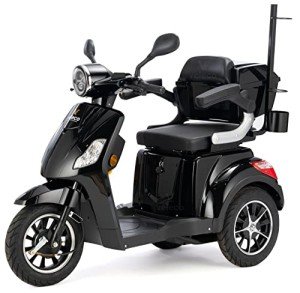Understanding Mobility Scooters: A Comprehensive Guide
Mobility scooters have ended up being an important tool for individuals who face mobility challenges, providing independence and a means of transportation. They are created to assist users in browsing numerous terrains, whether inside or outdoors, allowing them to engage more fully in everyday activities. This post will explore the types of mobility scooters, their functions, advantages, and considerations for potential users.
What is a Mobility Scooter?
A mobility scooter is a motorized lorry produced individuals with physical restrictions. It helps users keep their mobility and self-reliance, providing an efficient ways of transport over brief ranges. While they might look comparable to small electric cars, mobility scooters are usually powered by batteries, with controls created for ease of usage.
Kinds Of Mobility Scooters
There are several types of mobility scooters available in the market, each designed to cater to different needs and choices. Here's a breakdown of the most typical types:
| Type of Mobility Scooter | Description | Best For |
|---|---|---|
| Three-Wheeled Scooters | These scooters provide exceptional maneuverability and small turning radius however might do not have stability. | Indoor use and tight areas. |
| Four-Wheeled Scooters | Often more steady than three-wheeled designs, these scooters are perfect for outdoor use. | All-terrain travel and outdoor activities. |
| Portable Scooters | Lightweight and foldable, these scooters are created for easy transport. | Travelers and individuals with limited storage area. |
| Sturdy Scooters | Developed for larger users, these are robust and can manage heavier weights, frequently geared up with better battery life. | Users requiring extra support and stability. |
| Feature-Rich Scooters | These might include sophisticated innovation such as Bluetooth connection, integrated GPS, and adjustable seating. | Tech-savvy users searching for comfort and convenience. |
Secret Features of Mobility Scooters
When choosing a mobility scooter, buyers should consider a number of important functions. The following list outlines vital factors that can greatly affect their experience:
- Weight Capacity: Understanding the scooter's weight limit is essential to ensure safety and performance.
- Battery Life: A longer battery life equates to more prolonged use between charges, which is vital for lengthy trips.
- Speed: Typical mobility scooters can reach speeds between 4 to 8 miles per hour, however it's vital to choose one that fits the user's requirements.
- Convenience: Look for adjustable seats, armrests, and backrests that boost the total riding experience.
- Mobility: If traveling often, a lightweight and foldable scooter is beneficial.
- Surface Capability: Some scooters are better geared up for rough terrains, while others work best on smooth surface areas.
Advantages of Using Mobility Scooters
Mobility scooters provide numerous advantages that can substantially enhance users' quality of life. These consist of:
Increased Independence
Lots of individuals who battle with mobility rely on family or caretakers for transport. Mobility scooters empower users to move about easily and conduct errands on their own, cultivating a sense of independence and self-sufficiency.
Improved Quality of Life
Having the ability to travel unassisted can lead to social engagement, improved psychological well-being, and overall much better lifestyle. Users can take part in social activities, check out family and friends, and explore their neighborhoods.
Cost-Effectiveness
Compared to other mobility aids or services, mobility scooters can be more affordable. They can get rid of the need for expensive changes to homes or reliance on transportation services.
Adjustability and Customization
Many mobility scooters include choices for personalization, guaranteeing that users can customize them to best satisfy their individual needs.
Considerations Before Purchase
Before choosing on the right mobility scooter, potential purchasers must keep these considerations in mind:
- Lifestyle Needs: Assess how the scooter will suit daily regimens, consisting of the frequency and locations of usage.
- Trial Rides: If possible, taking a couple of models for a test drive can help assess convenience and maneuverability.
- Spending plan: Costs can differ widely, so defining a spending plan upfront is important.
- Service warranty and Service: Always think about the warranty used and the schedule of customer care in case of repairs.
Frequently Asked Questions About Mobility Scooters
1. How fast do mobility scooters go?
Mobility scooters usually vary from 4 to 8 miles per hour, depending upon the model and its power capability.
2. Are mobility scooters covered by insurance coverage?
Numerous insurance plans may cover part of the cost if a medical professional recommends the scooter; however, policies vary substantially.
3. Can I drive a mobility scooter on the roadway?
This depends upon local laws and guidelines. In some areas, mobility scooters may be allowed on public roads, while in others, they are limited to walkways and paths.
4. For how long does the battery last?
Battery life typically depends upon the scooter design and type of usage. Common mobility scooter batteries can last anywhere from 6 to 12 miles on a single charge.
5. Are mobility scooters safe?
Mobility scooters are generally safe when utilized properly. It's vital to acquaint oneself with the controls and operate them properly.
Mobility scooters play a crucial role in the lives of individuals with mobility difficulties. By understanding the types, features, benefits, and factors to consider connected with these automobiles, users can make informed options. This can lead to increased independence, a much better quality of life, and renewed access to the world around them. Whether for read review , errands, or leisure activities, a mobility scooter can be a life-altering investment for numerous individuals.

